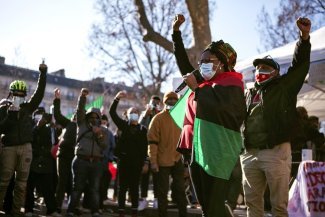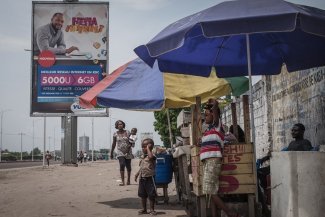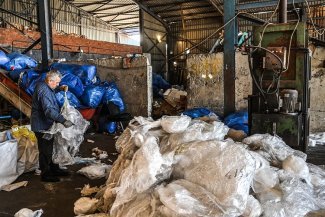USAID estimates that 1.4 million people will face acute food insecurity between March and May this year as a result of the fighting.
Muyenge Trouble, a mainly agrarian village with a once dynamic farming population on the leeward side of Mount Cameroon, is one of the many communities ensnared by the violence that has swept through Cameroon’s English-speaking regions since 2017. Tassa Tassa Paulinus used to live there. But the life of this middle-aged plantain farmer has been turned upside down ever since he was forced to flee his home in November with his five-year-old daughter, trekking through dangerous bush paths to the relative safety of Muyuka, a town over 30 kilometres away.
“I could no longer live in Muyenge as it had become a veritable ‘red zone’. The Amba Boys [armed separatists] of the Ambazonia Defence Forces made life very difficult. They kept demanding money from me,” Tassa explains. The farmer says he could have paid them for ‘protection’ if he had been able to sell his produce. But since the fighting between government forces and militant separatists began, the traders who used to frequent Muyenge Trouble have stayed away; they want to avoid running into lethal clashes and they don’t want to negotiate their way through the checkpoints mounted by rebel fighters in the area.
“At one point in time, I harvested over 400 bunches of plantain from my farm, but no buyers came. They all got rotten. A week later, the Amba Boys came for more money. I had to leave,” says Tassa, who has not seen his wife since she was kidnapped by the Amba Boys last September.
Away from Muyuka, which is 27 kilometres away from Buea (the capital of the Southwest Region, which, along with the Northwest Region, is where the so-called ‘Anglophone crisis’ is taking place), Martin Ekoke Sona is another farmer who has seen his dreams go up in smoke due to the conflict. The 30-year-old had been planning to set up a large yam plantation. “I had planned to cultivate yam on a large scale. But just before the farmland was due to be cleared, a school in the area was razed to the ground in an arson attack. That forced me to abort the project,” recalls Sona, who lost about half a million CFA francs (US$862) in the process.
At the time, Sona had just completed a six-month intensive entrepreneurship programme sponsored by the African Union’s New Partnership for Africa’s Development (NEPAD) and other partners. He feels frustrated that he hasn’t been able to utilise his new-found skills due to the conflict. “I now do yam seed multiplication, and I can barely produce 300 seeds in six months. If we were in peace time, I could produce 1,000 or more yam seeds over the same period.”
Food crisis on the horizon?
In the Northwest and Southwest Regions, where as much as 70 per cent of the population is involved in agriculture, ordinary people are now facing crop failure, food insecurity and job losses thanks to a conflict that started in October 2016 when English-speaking lawyers began protesting the appointment of French-speaking judges to their courts.
A few other frustrated groups, among them teachers, later joined in peaceful rallies.
Initially, protestors were calling for an end to decades of under-investment and government policies which they felt discriminated against the country’s English-speaking regions. However, the government of President Paul Biya (Cameroon’s ruler since 1982) responded to the protests with force, pushing many moderates to get behind separatists calling for an independent state they want to call ‘Ambazonia’.
To date, over 1,000 people have been killed in the fighting, according to local human rights groups, while the United Nations Office for the Coordination of Humanitarian Affairs estimates that insecurity and violence in these two regions have uprooted 437,000 people from their homes and forced over 32,000 to seek refuge in neighbouring Nigeria. An estimated four million people have been affected by the conflict.
With no peace agreement or inclusive national dialogue in sight, the possibility of the conflict ending soon becomes more elusive with each passing day. The uptick in violence, which started in September 2017, has scared people away from their fields, restricted population movements and limited access to markets, thereby exacerbating the population’s vulnerability to acute food insecurity.
According to United Nations Resident Humanitarian Coordinator for Cameroon, Allegra Baiocchi, hundreds of thousands of people in Cameroon need urgent assistance and protection. “Attacks against civilians have increased and many conflict-affected people are surviving in harsh conditions without humanitarian assistance due to the dramatic underfunding of the response [Humanitarian Response Plan]. Cameroon today can no longer be a forgotten crisis; it needs to be high on our agenda,” Baiocchi said in a press release in January.
The severity and magnitude of the situation is such that the United States Agency for International Development, USAID, estimates that 1.4 million people in Northwest, Southwest and West regions will face stressed (Phase 2) levels of acute food insecurity between March and May this year. In addition, nearly 486,000 people – approximately seven per cent of the three regions’ total population – will face crisis (Phase 3) conditions during the same period. Phase 5, which is catastrophe and/or famine, is the highest level of acute food insecurity.
Professor Ernest L. Molua, a renowned agro-economist and Dean of the Faculty of Agriculture and Veterinary Medicine at the University of Buea tells Equal Times that abandoned farmlands, the persistent harassment of those farmers who decide not to flee, abandoned field crops and stolen harvests have all contributed to low production levels and a shortfall in market supply. “This has led to a 4-5 per cent growth in staple food prices.” An average bunch of plantain for example, which previously sold at CFA2,500 (US$4.3) now sells at between CFA3,000 (US$5) and CFA3,500 (US$6).
He continues: “These increasing prices are seen as attractive by traders in the western flank of the Littoral Region who divert supplies away from the food markets in Douala [Cameroon’s economic capital, which is situated in the Littoral Region] to towns deemed safe in the neighbouring Southwest Region.”
“We can no longer sell our cocoa”
In Cameroon, cash crops have felt the brunt of the conflict’s impact on agriculture. The Southwest Region represents 45 per cent of total national cocoa production while the Northwest Region represents 70 per cent of total national arabica coffee production. In both regions, farming and post-harvest operations of these cash crops have been reduced to a bare minimum.
Che Divine, a cocoa farmer in the Mbonge area, west of Cameroon, tells Equal Times the production process has become more difficult since fighting began. “We are compelled to pay CFA30,000 (US$52) to the Amba Boys during each harvest. And the harvest has been poor because we don’t treat the cocoa trees well due to the lack of chemicals.”
Esapa Patrick Enyong, president of the Southwest Farmers’ Cooperative Union, which unites over 10 cooperatives, confirms that the agricultural sector has taken a turn for the worse: “Things are very slow at the moment because of the crisis. We are making huge losses as we can no longer sell our cocoa directly at the port in Douala.”
The situation is so bad that during the 2017/18 cocoa season, the Southwest Region lost its first place as the country’s biggest cocoa producer to the Centre Region, passing from 45.45 per cent of the national production to 32 per cent, causing a production deficit of 43,000 tons.
The Cameroon Employers’ Union, GICAM, reports that in 2018 the country lost CFA56 billion (US$96 million), 20 per cent in relative terms, in cocoa and coffee export revenues due to the crisis. Some 210,000 cocoa farmers in the Southwest Region alone were affected, causing farmers to lose as much as CFA35 billion (US$60 million) in income.
Another major hurdle to cocoa production has been the transportation of cocoa beans from production basins to the port city of Douala for export. Armed separatists have sabotaged various road networks and have even hijacked and burnt truckloads of cocoa from licensed buying agents (who they consider to be in cahoots with the government). The country’s National Cocoa and Coffee Board registered a stockpile of 7,212 tons of cocoa in the 2016/17 cocoa season, a figure that increased to 27,159 tons in 2017/18.
Cameroon Development Corporation
But if there is one entity that has been dealt the biggest blow by the conflict, it is the Cameroon Development Corporation (CDC), an agro-industrial parastatal group that grows, processes and markets tropical export crops such rubber, banana and palm oil. It is the second highest employer after the government civil service, with a workforce of over 22,000 employees.
Armed separatists have ground processing mills to a halt. Warehouses have been set ablaze and labourers have been chased out of plantations, some have even had their fingers butchered.
Of CDC’s 29 production sites across the country, 12 have been shut down, 10 are partially functioning while only seven are fully operational. The company’s precarious financial situation has caused job loss for 6,124 employees, while 5,805 more jobs could be lost as the conflict persists, representing 70 per cent of CDC’s workforce.
Franklin Ngoni Njie, the general manager of CDC, says CFA29.6 billion (US$51 million) is needed to get the company back on its feet, “but insecurity remains a huge hindrance to the accomplishment of this goal.” He fears the CDC may collapse without an urgent intervention.
This is the fate that has befallen previously notable companies such as the parapublic agro-industrial company Pamol Plantations. Many small to medium-scale farmers in the affected regions have also been badly hit. Mkong Cynthia Jeh, a graduate teaching assistant of agricultural economics and agribusiness at the University of Buea says the current state of affairs has also had a huge, negative impact on foreign exchange. “The cash crops can no longer be produced and exported as before the crisis. It will require huge amounts of money to get back to normal when the fighting stops.”










